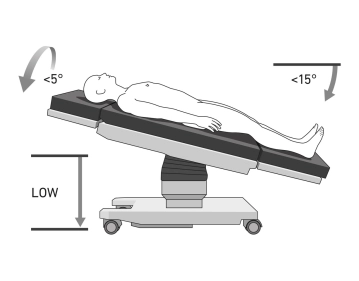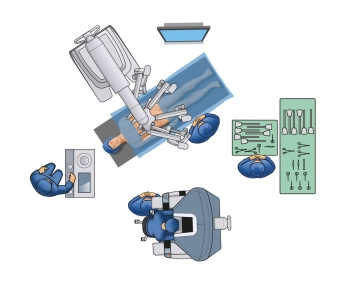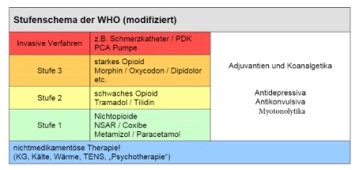Note:
Postoperative care should be integrated into a fast-track concept as "enhanced recovery after surgery" (ERAS). The goal is rapid recovery and reduction of postoperative complications and hospital stay. Key points of the perioperative ERAS concept are:
· preoperative eutrophy and normovolemia with fluid intake up to 2 hours preoperatively,
· contemporary anesthesia management and use of regional techniques,
· minimizing the use of drains and invasive accesses,
· as minimally invasive blood-sparing surgical technique as possible,
· postoperative pain management with reduction of opioid requirement,
· early mobilization,
· early nutritional build-up and
· timely discharge planning using discharge management.
Postoperative Analgesia:
Note: Various scales are available for quantifying postoperative pain, allowing the patient to determine their pain level multiple times a day, such as the NRS (numeric rating scale 0–10), the VAS (visual analog scale), or the VRS (verbal rating scale).
Caution: Strive to minimize the use of opioids and NSAIDs (adverse effects on bowel motility and anastomotic healing)
- Epidural catheter by anesthesia pain service removed on the 3rd postoperative day
- Basic medication: Oral analgesia: 4x1g Novalgin/3x1 g Paracetamol, also combinable, e.g., fixed Novalgin and as needed Paracetamol up to 3x/day
- Administration of Novalgin: 1g Novalgin in 100 ml NaCl solution over 10 minutes as IV infusion, or 1 g as a tablet orally or 30-40 drops Novalgin orally
- Administration of Paracetamol: 1g IV over 15 minutes every 8h, or 1g suppository every 8h rectally (Caution: consider anastomosis height), or 1g as tablets orally
Caution: The basic medication should be tailored to the patient (age, allergies, renal function).
- As-needed medication: If VAS >= 4, as needed Piritramid 7.5 mg as IV infusion or SC, or 5 mg Oxigesic acute
- If pain persists postoperatively >= 4, administration of a sustained-release opioid (e.g., Targin 10/5 2x/day)
Note: If pain occurs only during mobilization, an as-needed medication should be given 20 minutes before mobilization.
Note: Follow the link to PROSPECT (Procedures Specific Postoperative Pain Management) and to the current guideline for the treatment of acute perioperative and post-traumatic pain and observe the WHO step scheme.
Postoperative Measures:
- Monitoring: post OP: Recovery room, avoid ICU/IMC if medically possible
- Venous accesses: Central venous catheter removed by the 1st postoperative day, leave one peripheral line,
- Nasogastric tube removed at the end of the operation
- Urinary catheter: removed by the 1st postoperative day
- Drain removal: Target drain removed after determination of pancreatic enzymes and serum-equivalent values from the 3rd postoperative day
- Mobilization: Early mobilization on the evening of the operation. Gradual resumption of physical activity, full load when symptom-free, e.g., on the day of the operation in the siesta chair, standing and walking in the room from the first day, mobilization in the corridor from the 2nd postoperative day
- Physical therapy
- Breathing exercises
- Nutritional build-up: Sip drinking + yogurt/high-calorie drink on the day of the operation, tea/soup/yogurt + high-calorie drink on the 1st postoperative day, light full diet from the 2nd postoperative day
- Infusion: 500-1000 ml on the first postoperative day, thereafter only if oral fluid intake is insufficient
- Antibiotics: Single-shot intraoperatively, no further administration required
- Thrombosis prophylaxis: In the absence of contraindications: for moderate thromboembolic risk (surgical procedure > 30 min duration): low molecular weight heparin in prophylactic (usually "Clexane 40"), possibly in weight- or disposition risk-adapted dosage until full mobilization is achieved, physical measures, compression stockings
Note: Follow the link to the current guideline on prophylaxis of venous thromboembolism (VTE)
Caution: when administering heparin, consider: renal function, HIT II (history, platelet monitoring),
- Possibly stool regulation/bowel activity: from the 1st postoperative day: Macrogol 1-3 sachets/day, the first bowel movement should occur by the 3rd day, maintain high-normal potassium, laxative regimen: 1. Tea with Laxoberal/Dulcolax suppository, 2. Prokinetics: MCP / Prostigmin IV, 3. Neostigmine SC or IV, possibly Relistor when opioids are administered
- Blood work: on the 1st postoperative day, and then every 2-3 days with normal progress until discharge, immediately if clinical deterioration occurs,
- Blood glucose profiles
- Pancreatic enzymes from drainage secretion before drain removal, e.g., on the 3rd postoperative day
- Dressing every 2 days, with cutaneous suction dressing every 5 days
- Nutritional counseling
- Clips/sutures: if not absorbable, removed after 8-10 days
- Discharge: From the 5th postoperative day
- Sick note: Individually determined – based on the degree of recovery and the type of work, e.g., office work after 3 weeks post OP, physical work after 4 weeks post OP
- Follow-up care:
- Dependent on histological findings, usually no specific follow-up care required for benign conditions
- For newly developed diabetes mellitus: diabetic management
- Discharge letter: The discharge letter should contain information about: Diagnosis, therapy, course, histology, comorbidities, current medication, continuation of VTE prophylaxis, postoperative nutrition
- Rehabilitation (AHB): if required/desired: register through social services



